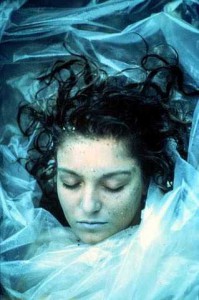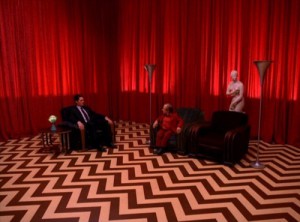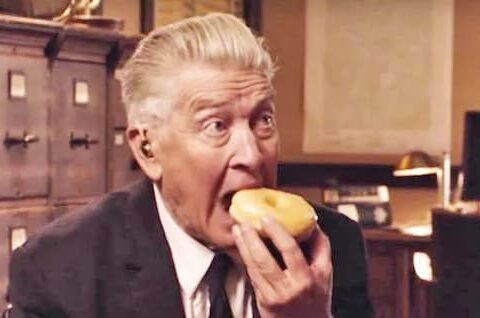I cannot think of any TV news that has been more exciting or intriguing than hearing that the iconic 1990’s David Lynch serial Twin Peaks is returning to our lives.
On October 6th it was confirmed the classic show will return for a 9-episode limited series to air in early 2016 on Showtime in the US.
It feels like an unreal prospect to me: I never even considered Twin Peaks would ever be on the cards again. It had seemed like pie in the sky: and not even something David Lynch would be interested in.
For a show that only had two seasons and ended over twenty years ago to still have so much of a legacy and that degree of loyal following is remarkable.
But Twin Peaks was groundbreaking. At the time there had been nothing like it, no point of reference for comparison. Even now it remains an entirely unique entity, despite the preponderance of TV dramas and series’ now and in the intervening two decades. David Lynch and Mark Frost’s iconic series is credited with having set the standard for most of the best TV drama-based series’ that have followed and is cited an influence on everything from The Sopranos to Mad Men; but I would argue that nothing has surpassed it for its uniqueness, impact and singular fascination.
There is nothing as surreal as Twin Peaks. Also nothing as disorientating. Nothing as weird. And, as far as endings go, nothing as psychologically unsettling.
Even with everything that’s come after it, Twin Peaks still stands alone in the annals of TV history as something pretty much inimitable.
With its off-beat tone, surrealist take on small-town suburban America (with dubious morality and Satanic undercurrents), eccentric characters and its opening premise of ‘big city detective’ arriving to solve the brutal murder of small town’s idyllic homecoming queen, it’s easy to see how the show could’ve generated such fascination in the first instance, being part mock-soap opera, part supernatural/horror and part god-knows-what.
Before it spiralled into a whirl of confusion, surrealism and esoteric mind-fuckery, it was actually being mostly perceived and treated as a straightforward (if off-beat) murder mystery and small-town soap opera. Little did TV audiences (and reviewers) know that this was merely a Trojan Horse… and that Lynch and Frost had something else in mind entirely.
It was the soap-opera/murder-mystery premise that was what made Twin Peaks a mainstream breakthrough ‘hit’ in the first instance: most critics thought Lynch and Frost were just parodying the hackneyed institution of the American soap opera and adding in some surrealist spice.
I’m not sure they could’ve predicted the insane levels of bizarre left-turn the narrative would end up taking. If – as is widely reported – the audience figures dropped dramatically in the second season, I always suspect it wasn’t because the Laura Palmer murder was solved (which is the reason usually cited), but because the show just got too weird and too uncomfortable for a lot of viewers.
For some, perhaps even too indecipherable.
I mean, there’s still stuff even I – a fan – haven’t entirely grasped or understood to my satisfaction. Twin Peaks is a maze of riddles, incomplete thoughts and lingering uncertainties.
Maybe that’s one of the reasons it’s so addictive: we keep wondering, keep probing, keep asking questions, and even struggle to decode the answers when they’re occasionally given. Twin Peaks is a hall of mirrors that the wandering mind gets lost in; even trapped in.
In fact, the more I think about it, the more the plight of Agent Cooper in that Season Two finale seems to symbolise this: trapped, perhaps forever, in a disturbing and unsolvable puzzle.

I was only ten years old when I watched Twin Peaks for the first time; literally staying up to watch the first episode when it premiered on the BBC. It was the first ever drama series I had watched from the pilot; but the promo hype that preceded that first air date worked its magic on me. From that opening episode – in fact from the famous scene of Laura Palmer’s body being fished from the river – onward I was hooked all the way through to the end of the second season and its disturbing finale.
I shouldn’t have been watching it as a ten-year-old. But my Dad was watching it, so I managed to get in on it too. But I had nightmares because of that show: hell, elements or moments from that show still haunt me even now.
But the funny thing is that, even not grasping so much of it at the time, I was addicted anyway; it must’ve been the style and tone of the thing more than anything, the weirdness, the oddball characters and the numerous highly stylized, highly memorable moments or motifs scattered throughout the two seasons.
The question ‘Who Killed Laura Palmer?’, even though it was THE question of early 90s television (possibly until ‘Who Shot Mr Burns?’), actually became secondary to the ongoing narrative; the investigation into her murder, the journey of Agent Dale Cooper through this bizarre labyrinth of creepy small-town suburbia, became more interesting than the case itself.
That was certainly the case after the murder was solved with still so much of the series left to go. While some viewers claimed to have lost interest after that point, especially as the show got weirder and weirder, I wasn’t one of them.
There were moments and visuals in Twin Peaks that stay in your mind forever, becoming part of your subconscious landscape; from the evocative opening title sequence with its moody images, famous theme music and the ‘Welcome to Twin Peaks’ sign, the image of Laura Palmer’s discolored face wrapped in plastic, to the unsettling dancing dwarf (The Man From Another Place), the ominous and cryptic Giant and the terrifying entity ‘Bob’, and most of all that mystical realm beyond the Red Curtains of the “Black Lodge” in the woods where Laura Palmer is murdered (and where Agent Cooper eventually loses his soul).
All of that off-kilter imagery is still very much a part of my subconscious tapestry: probably in a scary way more than anything else. Twin Peaks really has a way of penetrating into the darkest recesses of the mindscape and staying there.

Twin Peaks is psychologically unsettling in a way that straight horror never can be.
With its off-kilter, reversed-speech business (bringing to mind the enduring fascination some people have with ‘satanic’ ‘back-masking’ and backtracking in pop music) and otherworldly currents it might contain some of the weirdest, yet most compelling, sequences of scenes in any television show or film ever made.
Again, I had nightmares about Cooper’s Black Lodge experience when I was younger. That final episode of the series remains one of the most shocking finales to a TV series there’s ever been; I still think it may be the best series finale I’ve ever seen. The trauma – as a viewer – is on multiple levels: it is part psychological trauma, part visceral fear and anxiety, and part intellectual trauma (if there can be such a thing).
The intellectual trauma comes from the near-paralysis of the intellect itself: the inability of the critical mind to fully comprehend or decisively make sense of, the disturbing situation.
I mean, this series ended with our protagonist literally losing his soul, getting trapped in an occult hell dimension and being taken over by the very evil he’d spent the series trying to solve.
On the one hand, with that finale and that final scene the story seems finished enough, as though adding to it now might be unhelpful to the narrative. On the other hand, I’m not going to pretend the prospect of more Twin Peaks doesn’t appeal to me.
Also, although the Season Two finale seems like a difficult act to follow, the same can’t be said for the follow-on feature-film Fire Walk With Me, which despite some good moments, was nothing like on the same quality level as the TV series.
If nothing else, Fire Walk With Me should not be the final creative statement of the Twin Peaks mythology. And now it won’t be.
Another thing briefly worth touching on here is how much Twin Peaks seems to play with occult symbolism, real-world esotericism and even the shadier corners of real-world history.
At times, these references and invocations are so prominent that they’re pretty much integral to the Twin Peaks mythology: meaning that Mark Frost and David Lynch very much intended it.
Which raises the question of whether Frost and Lynch had knowledge of certain things and decided to tell a story utilising or encoding some of those things; either to simply enhance or expand the main narrative or… perhaps even to act as a below-the-radar ‘exposé’ of sorts.
Examples?
The reversed-speech or backward-talking thing definitely has occult resonances. You also have the recurring owl symbolism: which seems to resonate with supposed real-world paranormal experiences, including some UFO phenomena.
You have the fact that agents of government agencies appear to be toying with or investigating dark, occult forces, possibly including interdimensional beings: which is something conspiracy theorists have been insinuating for decades.
You even have direct references to the real-world ‘Project Bluebook’ – which the character Major Briggs was part of. And even through the demented Windom Earle, we learn that groups within intelligence agencies are well aware of the occult, evil forces at play in Twin Peaks and may even be directly involved with them.
Even the show’s central narrative itself – the murder of Laura Palmer – has a definite sense of ritual murder or ‘ritual sacrifice’ to it. Was Laura Palmer a Satanic-style sacrifice? Is the terrifying entity ‘Bob’ meant to represent the Devil – or some manifestation of the Devil? Something like this was never overtly stated in the show; but the implications are there.
The visual design of the ‘Black Lodge’ has a definite feel of masonic or secret-society associations. Even the fact that said horror-dimension hidden in the woods is referred to specifically as a ‘lodge’ seems significant.
For that matter, Laura Palmer could easily be re-contextualised as some kind of MK Ultra victim: and half the characters in Twin Peaks seem like they’ve been subject to mind manipulation MK-Ultra-style. Certainly there’s an ever-present feeling that the town is hiding a dirty secret that is never spoken of aloud: as though the tiny town of Twin Peaks could be some kind of MK-Ultra community or controlled group.
With all of that in mind, it’s also interesting that Twin Peaks as TV series came not long after the ‘Satanic Panic’ that gripped America in the 1980s.
It is also curious that the location of Twin Peaks was specifically a logging town in the Pacific Northwest: which seemed to have acquired a real-world stigma of sorts for serial killers and murders (at least according to a few things I’ve seen).

The airing of Twin Peaks also happened to coincide with or resonate with the Pacific Northwest music scene’s explosion into widespread popular consciousness in 1991/2, which is a curious concurrence. In fact, if you read Kurt Cobain’s recollections of his hometown of Aberdeen, Washington, you’ll notice how much that small, depressed, logging town sounds like the fictional town of Twin Peaks. In fact, I remember a music press interview with the band Tad from somewhere around that time and they were asked if they were watching the show: to which one of the band members replied, “Why would I watch it – I live it!”
These are all considerations that I of course never had back in the nineties. It’s only as I’ve gotten older, and with the benefit of hindsight, I can see some of these things: and am forced to wonder what precisely Lynch and Frost were trying to communicate (if anything at all).
Presumably, some viewers back in those days would’ve seen all these implications and resonances right away: and I wonder whether that added to their investment in the show.
But certainly, the older you get – and the more real-world points of reference you accumulate – the more you realise that Twin Peaks isn’t just surrealist fantasy or artistic absurdism: but something that does in fact connect to real-world elements in a way that actually makes it even more disturbing.
Again, Twin Peaks is – by design – a major mind-fuck.
The die-hard fans who’ve been waiting 21 years for more of the show are finally being rewarded for their dedication. In the wake of the new announcement, sales for the annual Twin Peaks Fest (which has been going every year since 1993) have reportedly shot up. Agent Cooper’s catchphrase (though I’m not sure he said quite as many times as is made out) is trending on Twitter and water-cooler speculation about Twin Peaks is going to come back, if only briefly.
At any rate, whether the charm and appeal of the original series can be recaptured in 2016 remains to be seen.
Capturing that same magic a second time might be a difficult task, particularly with two decades elapsed inbetween. But it’s highly unlikely David Lynch and the creative forces would’ve decided on adding to the legacy of the show unless they felt it was creatively worthwhile.
And it’s David Lynch, so, you know… it’s not going to be anything obvious or straightforward.
What is the story going to consist of now that the Laura Palmer murder mystery is long resolved? What is the fate of Agent Cooper? Lynch is keeping understandably tight-lipped about details at this time; we’ll have to wait and find out in 2016.
Until then, remember – “The owls are not what they seem.”




